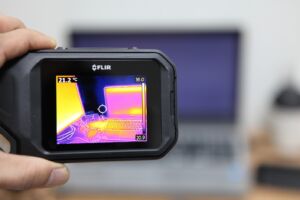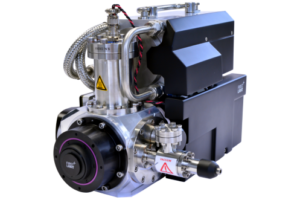Today’s post on thermal imaging cameras is prepared by a guest blogger – Amanda Wilson – a technical blogger specializing in the electrical and electronic test equipment and measurement industry.

A hand-held thermal imaging camera, Courtesy of Pixabay
What do military surveillance and navigation, skin temperature analysis, and cancer detection have in common? Thermal imaging cameras! These devices are being used widely across a slew of industries as a fast and accurate solution for measurements in almost any process involving emission or exchange of heat energy or temperature.
Though the principles of thermal imaging and thermography were established in 1960 by Sir William Herschel, a German-British astronomer who discovered infrared light, the technology and equipment have now been developed extensively for engineering, repair, and design applications in many fields that utilize technologies such as smart sensors, microcircuitry and WiFi connectivity.
Thermal imaging cameras are best suited for emergency response, product manufacturing, repair and maintenance, architecture analysis, medical diagnostics, environmental control and autopiloting systems.
What is a Thermal Imaging Camera?
- A thermal imaging camera is a handheld electronic device used to detect temperature or heat and display it as an image or a color map. The camera captures and creates an image of an object to represent the temperature gradient across it by using the infrared radiations emitted by that object.
- The color map represents areas of high and low temperatures, displaying the warmer regions as red, orange and yellow colors, moderate regions (room temperature) as green, and cooler regions as purple and blue colors. Some infrared cameras also display the temperatures in the image as just black and white regions for finer detail.
- The heat is detected by a heat sensor that is attached to the camera’s lens. The image generated by the thermal camera can be used to identify and analyze regions of excessive temperature, sources of wasted heat energy, overheating components, and even potential thermal insulation gaps.
A major advantage of the thermal imaging camera is the ability to convert infrared radiation, which is invisible to a naked eye, into wavelengths of visible colors on the electromagnetic spectrum that can conveniently be perceived and analyzed.
How do Thermal Cameras Work?
A thermal imaging camera works by detecting and measuring the infrared radiation or the heat energy emitted by objects and representing it in the form of an ‘image’ or a ‘thermograph’ (also known as thermogram). This is done using a special camera lens and an imaging sensor that is sensitive to frequencies in the infrared region of the electromagnetic spectrum.

The discovery of electron initiated avalanche photodiodes using mercury cadmium telluride (MCT) semiconductor materials permitted a significant breakthrough in SW IR imaging. Using unique HgCdTe sensors allows sub-electron readout noise. Courtesy of First Light Imaging SAS
The imaging or heat sensors are constructed as a grid of pixels, which convert the infrared wavelengths hitting them into electronic signals. The signals are then processed into a color map of different temperature values and gradients within the main body of the camera. The color map is displayed on the screen and can be used for further analysis.
The thermal camera generates images of infrared radiations that are invisible to the naked eye into a visible image, which is why the process of thermal or infrared imaging is also known as “invisible imaging”.
Eight Features and Specs to Consider
There are certain key features and specs of thermal cameras that you should consider before selecting one to meet your needs:
Resolution: A higher detector resolution means more pixels on the IR imaging camera. Improved spatial resolution means a larger field of view, while a lower spatial resolution value means better faster image processing and dynamic image rendering.
Focus: There are various focus mechanisms such as
- Fixed focus: A simple mechanism of ‘point and shoot’.
- Manual focus: Allows you to focus your thermal camera manually and precisely.
- Autofocus: Automatically focuses on a target but may require manual adjustment for higher precision.
- Laser-assisted autofocus: Uses a built-in laser distance meter to calculate the distance from the target and focuses accordingly.
- Multifocal mechanism: Captures and stores multiple images of the target from different focal distances and blends them into one high-precision finely detailed image using computer software.
Temperature range: Choose a thermal camera with a temperature range similar to that of your target so that it can capture the highest as well as the lowest temperatures in the image. For multifunctional applications, choose a camera with a wide temperature range that can automatically select the range based on your target, or allows you to set the range manually.
Lens: There are lenses for various applications such as standard, wide angle, telephoto, and macro lens. Depending on your need, choose a lens that best serves the purpose of capturing the right area of view with the best resolution. Some thermal cameras also allow you to change lenses based on the type of operation or the target.
Memory and sharing: Select a memory that can store the IR images such as a removable SD card, or a USB flash drive. Certain thermal cameras can also connect to WiFi and Bluetooth for sharing and backup of data, portable analysis, and report generation.
Color palettes: Some color palettes help bring out certain details that other colors may miss. Slight differences are easier to see with a monochromatic palette, such as grayscale or amber. While monochromatic colors such as grayscale or amber are good for detecting slight differences in temperature, high contrast color palettes can easily detect obvious anomalies.
Color alarms and spot markers: Color alarms can be used to highlight areas outside the normal temperature range of your target objects. Spot markers mark specific temperatures on the thermal image to compare simultaneous temperatures across different points.
Emissivity and reflected temperatures: Surfaces with low emissivity such as shiny metals can reflect infrared radiations from other objects. This phenomenon affects the accuracy of your IR image. Your thermal imaging camera should be able to adjust parameters for high accuracy and consistency. For best results, look for a thermal camera that meets or exceeds +/- 2% (or 3.6°F) accuracy.
Types of Thermal Imaging Cameras
There are three basic types of infrared imaging cameras: short wavelength, mid-wavelength, and long wavelength.
Short wavelength cameras: Short wavelength thermal imaging cameras capture infrared wavelengths in the range of 0.9 to 1.7 microns. These cameras have a high resolution as compared to the visible light spectrum in terms of shadow contrast and detail.
Mid wavelength cameras: Mid wavelength cameras capture infrared wavelengths in the range of 2 to 5 microns with higher resolution and accuracy. These cameras are typically used for extreme high-temperature readings such as scanning boiler applications and ballasted, single-ply roofing systems.
Long wavelength cameras: Long wavelength infrared cameras capture infrared wavelengths in the range of 7 to 12 microns. These cameras generate highly detailed images due to low atmospheric absorption.
Uses of Thermal Imaging Cameras
Thermal imaging cameras are widely used in:
- Safety – surveillance, search and rescue, firefighting, navigation, detection of gas and fluid leakages, repair and maintenance of mechanical, electric and electronic components, disease control, and more.
- Healthcare and Medical Applications – identification of muscular or skeletal problems, detection of cancers, detection of circulatory disorders, body infections, and even animal diagnosis and treatment.
- Heat and Electrical Applications – identification of electrical defects on printed circuit boards (PCBs) and solar panels, analysis of power usage, component behavior, and overheating, detection of loose connections, analysis of heat transfer, heat losses, heater performance, and refrigeration, and more.
- Mechanical Inspection, Non-Destructive Testing (NDT), and Maintenance – inspection and maintenance of HVAC, identification of overheated motors and defective motor vehicle parts, aircraft testing and maintenance, identification of blockages and leakages in pipes, vents and ducts.
- Industrial Applications – Industrial thermal imaging cameras certified specifically for challenging industry applications such as cameras to monitor explosives in the petrochemical industry, electrical hazards in the electrical industry, faulty components in the mechanical industry, etc.
Summary
Thermal imaging cameras can access components and units that are otherwise invisible to the naked eye. They are also very safe because thermal imaging is performed at a distance. Thermal imaging can quickly help detect faults, errors, failures and anomalies in electrical, electronic, mechanical, and other industrial components and processes.
While selecting an infrared imaging camera, you should consider parameters such as focus, resolution, lens, temperature range, color palettes, and in-built tools for reflected temperatures and emissivity. Thanks to advances in technology, thermal imaging has become more affordable, easier to use and suitable for a variety of industrial and commercial applications.
If you liked this article, you might also like the Complete Guide to Calorimeters.

It’s interesting to know that there are different kinds of wavelengths available when choosing a thermal surveillance camera. I’m thinking about having some installed in my property soon because one of the houses two blocks from where I live was robbed recently. I think that’s a wake-up call that I should take the security of my home seriously.
I just had to drop a comment after reading your fantastic blog post about thermal imaging. As someone who is always been intrigued by cutting-edge technology, I found your article incredibly informative and engaging. Thank you for shedding light on the incredible capabilities of thermal imaging. Your blog post was a true eye-opener and has left me even more fascinated by this powerful technology. I am looking forward to reading more of your insightful content in the future!
Delving into the realm of thermal imaging, this comprehensive piece elucidates the technology and applications, mechanics, and benefits. It explores diverse fields like industrial inspections, medical diagnoses, and scientific research. With lucid explanations and captivating visuals, it serves as a go-to resource for understanding the capabilities and limitations of thermal imaging cameras.